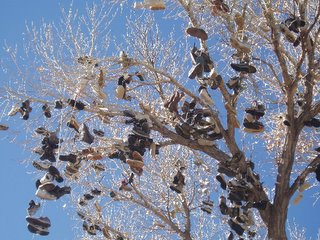More of the Loneliest Road in America

Friday, November, 18, 2005
"It's totally empty. There are no points of interest. We don't recommend it," said an Auto Club counselor in 1986 when asked about Nevada's Highway 50, and then he added, "We warn all motorists not to drive there unless they're confident of their survival skills."
Today's drive was longer than I planned, but in all was a great and very interesting trip. This morning I had intended to walk through Ely's historic downtown to take pictures this morning, but by the time I was ready, it was still really cold. Too cold to be out walking, but I did fill up with gas before leaving.
I headed west on Highway 50. This 287-mile stretch of highway has several distinctions: it became the nation's first transcontinental road, and in 1986 it was named the Loneliest Road in America. It passes nine towns, two abandoned mining camps, and a few gas pumps. It retraces the route of the Pony Express and Overland Stagecoach trails.
Nevada is the nation's most mountainous state with at least 314 ranges and peaks - many of them evident from today's drive. Except for the last 35 miles, the road is a series of ups and downs as it took me over nine mountain passes and through an equal number of high valleys. The mountain ranges along the way were the Eagan, White Pine, Monitor, Toquima, Simpson Park, Toiyabe, Shoshone, New Pass, and Desatoya. Most of these passes exceeded 7,500 feet in elevation, and had "chain up/off" areas and snow plow poles. This definitely is not a route to take during snowy weather.
The first town after Ely was Eureka. It is one of Nevada's best-preserved mining towns. The Eureka Opera House and the Courthouse, built in 1879, have been fully restored.
My plan had been to spend the night in Austin, an old silver mining camp. The small town is clinging to the mountainside (at 6,500 ft elevation) about midway down a very long, windy 6- to 8-percent grade. My RV guide said there were two RV parks, but I only saw one, and it didn't look good. It had a handful of old, run-down trailers on a small gravel parcel of land. I decided to continue on to the next good-sized town - Fallon. It meant driving an additional 110 miles.
Between Austin and Fallon I found several remarkable sights. Cold Springs, a Pony Express and Overland Stagecoach site in one of the long, high valleys, now has a bar and restaurant, motel, and RV park - all being served by solar energy. I stopped and visited with the waitress and barkeeper while I enjoyed a chocolate milkshake.

A few miles west of Cold Springs I rounded a curve and - "what's the matter with that tree?" I asked out loud. I could tell that the leaves had all fallen, but are those shoes hanging from the branches???? These questions formed as I passed. I was curious enough to look for a way to turn around and go back. It was about a mile before I could do just that. And, yes - the giant cottonwood tree was loaded with shoes. (see photos). I've since read that it is called "The Old Shoe Tree." The tradition of throwing shoes up is said to have started following an argument between newlyweds, during which one tossed the other's shoes into the tree. When they reconciled, the other reciprocated; and folks have been tossing their footwear into the tree ever since.
I passed a sign saying U.S. Navy Centroid Facility. What is that? OK, Navy friends, what is this?
Next as I came down a grade it looked like there was a huge lake ahead - on both sides of the highway. As I got closer, I realized that it isn't water. Rather it was somewhat like the salt lake beds that Tom, Jesse and I went to see in the Mountainaire area. It was rather squishy-looking, and in fact there were tire tracks here and there - some had sunk in quite a ways. This "lake bed" or whatever was on both sides of the highway for about 14 miles, extending a long ways to each side. Off in the distance was a huge mountain of sand that had ATVs crawling all over it. As I neared Fallon, I passed the Fallon Naval Air Station.
After driving through such isolated land and through such small towns, Fallon seemed huge and had a lot of traffic. Because I passed up Austin and drove more miles today than planned, I will spend two nights here in Fallon.
I settled in at the RV park at the Bonanza Casino. I have full hookups, a free roll of nickels for the one-armed bandits, a free bar drink and $2 off a meal at the casino restaurant! All for $15 for the night. I'm right across from a Walmart and Safeway store, a few blocks from a coffee shop with wireless Internet, and a few blocks from the main downtown. Tomorrow I'll explore this town.
Saturday, November 19, 2005
Well, Fallon isn't as big as I had thought. I explored the small downtown - just a few blocks long - and even though it is Saturday, several stores were closed. There's not much to see, but I did find a second-hand book store and stocked up on some books. I also cleaned the motorhome and did some shopping at Safeway. Tomorrow I'll drive the 80 miles to Gardnerville where I'll stay for several days. This will probably be my last post for a few days.

<< Home